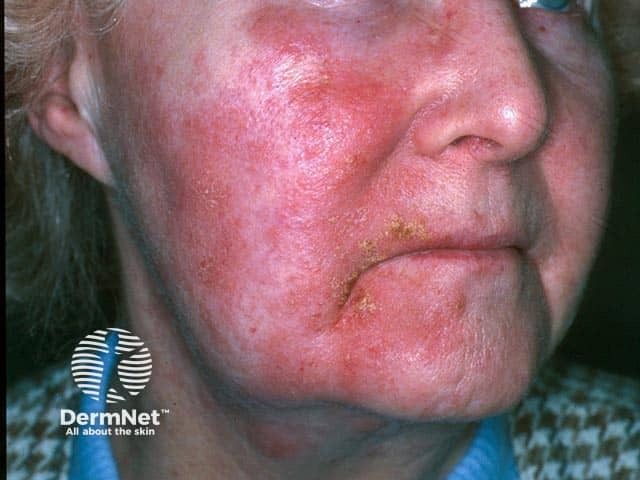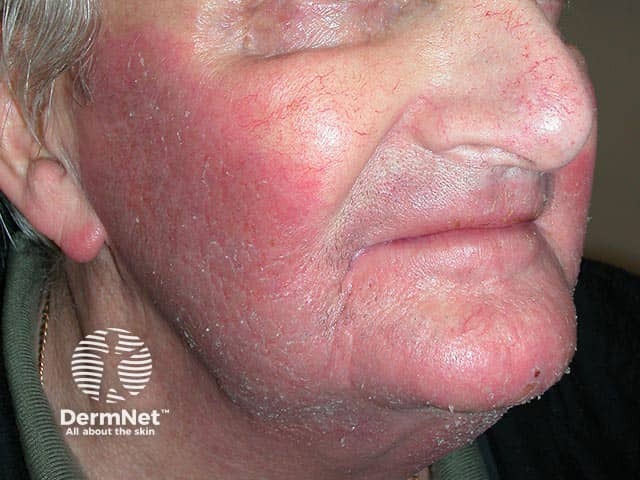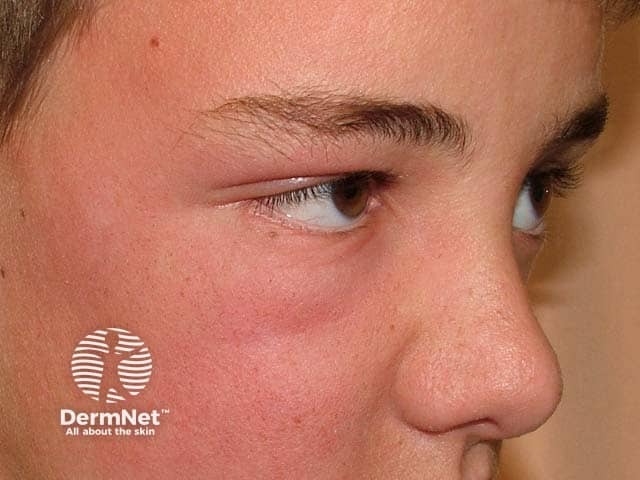Main menu
Common skin conditions

NEWS
Join DermNet PRO
Read more
Quick links
Consort allergic contact dermatitis — extra information
Consort allergic contact dermatitis
Last reviewed: September 2023
Authors: Dr Sabrina Sapsford. Dermatology Research Fellow, New Zealand (2023)
Reviewing dermatologist: Dr Ian Coulson
Edited by the DermNet content department
Introduction Demographics Causes Clinical features Variation in skin types Complications Diagnosis Differential diagnoses Treatment Prevention Outcome
What is consort allergic contact dermatitis?
Consort allergic contact dermatitis (CACD) is a skin reaction that occurs on allergen exposure from another person. The ‘consort’ is the person carrying the allergen that causes the contact dermatitis via close contact.
Consort allergic contact dermatitis is also known as contact dermatitis by proxy or connubial contact dermatitis. Because the allergen originates from another person, careful history-taking to deduce the cause of contact hypersensitivity is required.

Facial contact dermatitis due to allergy to partner’s aftershave

Facial contact dermatitis caused by fragrance in wife’s hair spray

Facial dermatitis due to neomycin allergy after putting antibiotic drops into pet dog’s ears
Who gets consort allergic contact dermatitis?
Anyone can develop consort allergic contact dermatitis. However, allergic dermatoses are more common in patients with other atopic diseases such as hay fever, atopic dermatitis (eczema), and asthma.
Most patients with consort allergic contact dermatitis are women. The most common consorts are partners/spouses, children, healthcare workers, and carers.
What causes consort allergic contact dermatitis?
Potential allergens include medications (36%), plants/botanicals (12%), fragrances (9%), and other occupational, cosmetic, or common household products.
In 80% of cases the patient has direct contact with the consort, resulting in a type 4 (cell-mediated) hypersensitivity reaction. Contact can also be indirect, for example, via clothing, sheets, or the environment.
- Up to 50% of consort contact dermatitis is caused by allergen exposure via a partner.
- Consorts may also include other family members, healthcare workers, or even pets (particularly topical medicaments applied to the animal).
- A caregiver relationship may be associated in up to 30% of cases.
Bedsharing partners may only be affected on the side of the skin exposed to the consort. One-third of partner-associated consort allergic contact dermatitis involves sexual contact and may be associated with condoms, lubricants, or feminine hygiene products. Semen can also rarely cause contact dermatitis.
History taking is important to deduce the cause of consort allergic reactions, including an occupational history of the patient and their close contacts. Associated occupations include manufacturing, pharmaceuticals, farming, hairdressing, and perfumery work.
What are the clinical features of consort allergic contact dermatitis?
The most common presentation of consort allergic contact dermatitis is an eczematous rash. Around 14% may develop a vesiculobullous rash. Other less common presentations include oedematous, nummular, follicular, and lymphomatoid dermatitis.
The distribution of the rash depends on the areas of the skin exposed to the allergen.
- The main area affected is the face (49%).
- Other commonly affected areas include the neck, arms, hands, and genital regions (from contraceptives, genital deodorants, and sex aids).
A high index of suspicion is required to diagnose consort allergic contact dermatitis; for example, a handprint-shaped rash may indicate exposure from the consort’s hand or glove.
How do clinical features vary in differing types of skin?
Rather than appearing erythematous (red), consort allergic contact dermatitis may appear violaceous (purple) or mute (no added colour) in darker skin types.
What are the complications of consort allergic contact dermatitis?
- Chronic itching.
- Impetiginisation of eczematous rash.
- Sleep disturbance.
- Psychosocial effects (eg, depression, relationship problems).
How is consort allergic contact dermatitis diagnosed?
Consort allergic dermatitis is diagnosed through careful history-taking. A patient’s close contacts and their occupational history, as well as sexual and other social factors, may be relevant.
Thorough examination of the rash is important. An unexpected pattern or distribution, or genital involvement, may suggest a consort allergic contact dermatitis.
Patch testing to determine or confirm the causative allergen can be helpful. An unexpectedly vigorously positive patch test in a patient with unexplained contact dermatitis may increase the index of suspicion for consort allergic dermatitis.
What is the differential diagnosis for consort allergic contact dermatitis?
- Contact dermatitis (direct): irritant or allergic
- Photocontact dermatitis
- Contact urticaria
- Atopic dermatitis/eczema
What is the treatment for consort allergic dermatitis?
General measures
When an allergen is identified, the best treatment is avoidance of the allergen. This does not mean avoiding the consort. However, it does require identifying the allergen and mitigating the risk of exposure to those sensitised to that allergen.
This may require the consort to keep work uniforms at work, and showering after work if the allergen is occupational. Other strategies may include consorts avoiding causative cosmetics, household products, or contact with patients sensitised to medications soon after using those medications (or even changing medications if possible).
Other general measures:
- Dry skin carefully after washing
- Avoid soap
- Moisturise with emollients.
Specific measures
- Topical medications (eg, topical steroid).
- Antihistamines as required.
- Short-course systemic steroids such as oral prednisone.
- Phototherapy may be considered if unremitting.
How do you prevent consort allergic contact dermatitis?
Allergen avoidance, once identified, is key to prevent recurrence of symptoms.
What is the outcome for consort allergic contact dermatitis?
With allergen avoidance, the reaction should resolve.
Bibliography
- Lee J, Guo S, Dinalo J, et al. Consort Allergic Contact Dermatitis: A Systematic Review. Dermatitis. 2022;33(3):181–186. doi: 10.1097/DER.0000000000000884. Journal
- McFadden, J. (2014). Proxy Contact Dermatitis, or Contact Dermatitis “by Proxy” (Consort or Connubial Dermatitis). In: Lachapelle JM, Bruze M, Elsner P, eds. Patch Testing Tips. Springer, Berlin, Heidelberg. Available here
On DermNet
